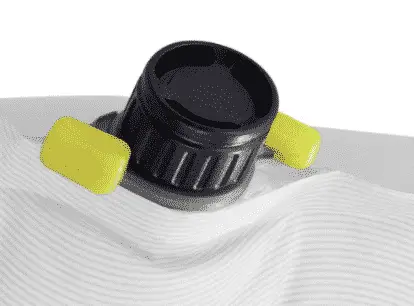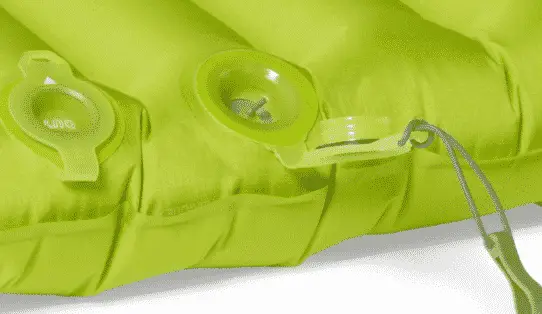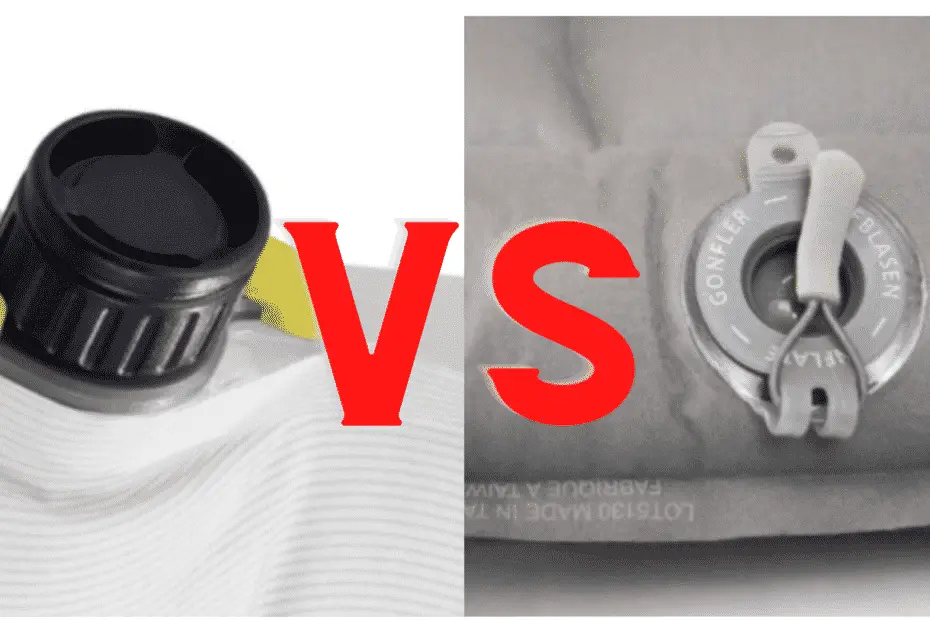Inflatable sleeping pads haven’t changed much over the past couple of decades, but valve styles have changed over the years. The old style twist lock valves are being replaced by flat valves and Theremarest even has a speed valve that works like a roll top bag. There are advantages and disadvantages to each valve style, but what type of valve is best?
Thermarest invented the twist and pull style valve in the early 70s and most companies still use a similar style today. Twist lock valves work great, but they have a slow flow rate and you can’t use an external pump. Exped created flat valves to solve both of those problems and multiple manufacturers have integrated the flat valve design into their pads.
The type of valve you choose will be a matter of personal preference. Do you want the time tested design of a twist lock valve, or a low profile flat valve that’s faster to fill up? Speed valves allow you to get around most of the issues with twist lock valves, but are they worth the extra price?
In the rest of this post I’ll go over the different valve styles and explain the advantages and disadvantages of each type of valve. If there was a clear winner you wouldn’t see different valve types so the choice is up to you.
Table Of Contents
Sleeping Pad Valve Types Explained
There are three different types of sleeping pad valves: twist lock valves, flat valves and speed valves (Thermarest Pads). You might see slight variations on the different valves, but they all use similar designs. So lets explain the difference between each type of valve.
- Twist Lock Valves: This is the classic valve style that uses tiny black cylinders at the end of the mat that you push in, twist, and pull out to inflate/deflate the pad.
- Flat Valves: Flat valves are a promising update that aims to fix all of the problems with twist lock valves. They have a three layer design that allows you to rapidly inflate and deflate the sleeping pad (I’ll Explain More Below.
- Speed Valves: Thermarest created a speed valve that uses a wide opening (about 12 inches wide) to blow surrounding air into the pad. It 2-3 large puffs of air to fill up your pad with air so there’s no need for a separate mechanical/sack pump.
I personally prefer flat valves, but they’re a little bit heavier than twist lock pads. The lightest ultralight sleeping pads will almost use a twist lock valve to cut 2-3 oz off the overall weight. Flat valves are so much easier to use, but is it worth carrying a slightly heavier pad? It depends on if you’re trying to get into an ultralight/lightweight setup.
That’s why Thermarest is by far the king of ultralight sleeping pads. The Thermarest Neoair Uberlite and XLite Pads are 4-6 oz lighter than the closest flat valve pad. Your trading convenience for a slight reduction in weight.
Twist Lock Sleeping Pad Valves (aka Twist and Pull Valves)

Twist lock valves are the classic way to inflate/deflate a sleeping pad. They were invented in the 70s by Thermarest and they still use basically the same design. It’s a tiny black cylinder at the end of the mat that you push in, twist, and pull out to open up the valve. Blow into the valve or use a pump and once it’s inflated you push it back in and twist the valve locking it in place.
Here’s a brief breakdown of the advantages and disadvantages of Twist Lock valves. I’ll go over each of these bullet points in detail further down.
Twist Lock Valve Advantages
- Lighter design than flat valves.
- Cheap and easy repairs to damaged valves.
- Time tested reliable design that can handle any conditions.
Twist Lock Valve Disadvantages
- No way to block airflow while blowing up the sleeping pad.
- Valve sticks out of the end so it’s easy to accidentally open the valve.
- More likely to accidentally damage the valve.
- Slower to inflate/deflate the pad.
I personally prefer modern flat valves, but there are a few advantages to twist lock valves. Twist lock valves are smaller and a few oz lighter than flat valve systems so they’re almost always used on Ultralight Sleeping Pads. Thermarest is the king of ultralight pads and their entire lineup is filled with Twist Lock valves. They’re not as convenient, but they shave a few oz of the trail weight.
It’s also much easier to replace a damaged/leaking twist lock valve. Most modern valves can be replaced by simply screwing in a new valve, but you may need to you need to use repair adhesive on older plug style twist lock valves.
Twist lock valves are extremely common and they work well, but there are a few issues.
- Twist lock valves don’t have a way to block airflow when you take your mouth or pump off the valve (this is only true for some valves). It’s like having a 3/4 inch hole in the side of your sleeping pad that you blow into. The second you take your mouth/pump off the valve air will leak out.
- The valve sticks out of the end of the pad so it’s easy to accidentally open them up and you’ll feel the valve throughout the night. I toss and turn at night and I’ve somehow managed to open up my valve dozens of times throughout the years.
- They’re more likely to get damaged than modern flat valves. The valve sticks out of the end of your pad so it’s easy to catch them on something, kick them, or accidentally step on it potentially damaging the valve. You can replace a leaking or damaged valve, but it’s not easy.
- Letting air in and out of the valve is much slower than with other valves. It’s not a terrible flow rate, but it will take at least 1 minute to manually blow up the pad with your mouth. Some pads have oversized valves and additional release valves to help with this problem, but they increase trail weight.
Consider Buying A Valve Attachment To Use Any Pump
Thermarest sells pumps that are specifically designed for their pads, but they’re not cheap. I use a NeoAir Micropump with my pads. Thermarest Pump Sacks are a little bit cheaper, but you can’t use any of the generic pumps without a valve adapter. You can pick up an Exped valve adapter for about $10 to use any pump with a twist lock valve.
Flat Sleeping Pad Valves

Most manufacturers have switched over to flat valvesover the past decade or so. Exped, Alps Mountaineering, Big Agnes, Kammock, Mountain Equipment, Nemo, REI Coop, and Sea To Summit all use flat valves in their sleeping pads. Thermarest and Klymit are the only companies, that I can think of, using twist lock valves.
Flat valves aim to fix all the problems with classic twist and pull valves. They lay flat against the pad so they don’t stick out, they inflate/deflate faster, less likely to get poked by the valve, and they never open up by accident.
If I’m being hones, flat valves outperform twist and pull valves in almost every way. The only problem is that some manufacturers (Thermarest) still use twist lock valves across their entire lineup. I really like Thermarest pads since they tend to be lighter than other options, but needing to use a twist lock valve sucks.
Flat valves have three parts to the design: first layer closes the valve completely, second layer controls airflow inflating/deflating the valve, and the 3rd layer allows you to quickly deflate the pad. The large opening allows you to quickly inflate/deflate the sleeping pad and the layers regulate airflow. Air won’t leak if you take a second to take a breath or talk while inflating the pad.
Flat valves were designed to be used with external pumps for inflation. You can either use a pump sack or small mechanical unit that attaches to the valve. Blowing them up manually is possible, but using a pump is much easier. Some pads also have two valves: one for inflation and another for deflation
Flat Valve Advantages
- Valve doesn’t stick out of the pad so your less likely to run into problems.
- Faster inflation/deflation times
- Almost impossible to accidentally open the valve.
- Multiple layers allow you to take short breaks to catch your breath without losing air.
- More durable than twist lock valves since your less likely to kick, or catch the valve on something.
- Designed to be used with sleeping pad pumps.
Flat Valve Disadvantages
- Heavier design than twist lock valves.
- Harder to repair leaking valves. You need to send it in for repairs, but they’re very durable so this is rarely a problem. Most of the time you can fix leaks by cleaning debris stuck in the valve.
Air Can Only Flow One Way With A Flat Valve
Air can only flow in one direction with a flat valve. The internal layers of valve block air from escaping when you’re inflating the pad. You won’t lose air when you take your mouth or the pump off the valve. So you can take a second to catch your breath while manually blowing in air with your mouth.
One way valves will also prevent leaking if you accidentally open the outer valve during the night. I’ve never heard of anybody losing air throughout the night with a flat valve. There’s no risk of accidentally unscrewing the valve in your sleep or not closing the valve completely.
Thermarest SpeedValve
The Thermarest Speedvalve uses a wide opening (about 12 inches) to quickly fill up your sleeping pad. Speedvalves don’t require an external pump to blow up the pad. I’ll to describe how to use a speedvalve, but you should probably watch the video for a better explanation.
Just open up the large speedvalve and blow into it from about 6 inches away. You can blow a lot of air into the pad fast since it forces the surrounding air into the sleeping pad (Bournoulli’s Principle Of Fluid Dynamics). It only takes 2-3 large breaths to completely blow up your pad so it’s faster than a flat valve and you don’t need a pump.
User error seems to be the major problem with Speedvalves. You need to be about 6 inches away or you won’t get much air into the pad. If you don’t blow correctly it will take way long to blow up the pad, defeating the purpose. Plus you can end up with a leaking pad if you don’t roll it up correctly.




